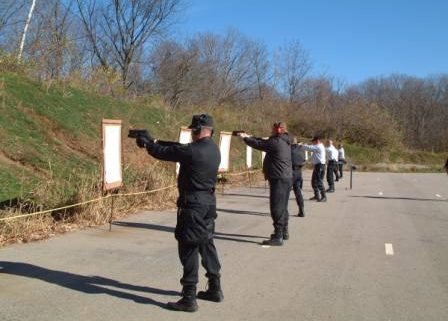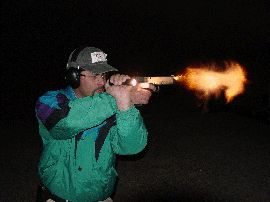Shooting For Survival: Are You Prepared?
Ready on the left? Ready on the right? Ready on the firing line. Commence firing!
Those words, or something similar, are heard by officers all over the country as they attend their annually mandated firearms qualification. Yes, once or twice each year all officers get the word to report to the range to qualify with their duty weapons. So many of them, for the first time since the last mandatory qualification, pull out the gun cleaning kits to spruce up the old sidearms. Then, with their pistols all clean and properly oiled, many of them begin to feel a bit of anxiety creeping up. Suppose I can’t qualify? What happens if my scores aren’t high enough? You know, my eyesight has gotten a little weaker since last year. What if I miss the entire target? Will I lose my job?
Well, those are worries that should never arise because officers should be required, or at least allowed, to shoot more often. Practice by repetition is the key to firearms proficiency. And budget woes should never affect an officer’s ability to defend him/herself. Yet, ammunition and training time are normally some of the first things to go when funds get tight. But that’s the way it is and that’s the way it’ll probably remain. So cops deal with what they have, which sometimes isn’t much. Still, do departments make the most of what little firearms training time they provide? Easy answer…NO. Most of them do not.
Many departments still have their officers line up on the range, wait for the command to fire, and then blast away at stationary paper targets, hoping they’ll punch enough holes in them so they can pass the qualification requirements. Then they call it quits until next year. But is that enough to survive in today’s increasingly dangerous world? Probably not.
Each week we report the line-of-duty deaths of the officers killed during the preceding week. And many of those officers were killed by gunfire, in shootouts with armed suspects. Not in gun battles with stationary paper targets. Now, I’m not saying that either of those officers weren’t properly trained. Not at all. Sometimes you do everything right and the worst still happens. What I am saying is that there are things that can, and should be taught to each and every officer that could help them in the field.
As I stated earlier, officers train best through repetition. And they train best by learning to react to various threats and situations…over and over and over again. Then, when those events present themselves, officers will revert to their training and react appropriately. Therefore, it is an absolute must that officers spend at least some time training under “threat” situations. After all, suspects on the street are simply not going to stand perfectly still with their hands hanging at their sides so that officers can squeeze off 50 or 60 rounds at them. So why should officers train as if they’re going to someday face a one-dimensional paper bank robber?
Sure, some practicing with stationary targets is necessary. That’s how cops learn the basics. But what else can they do to better prepare themselves for the real bad guys?
1. Shoot in low light situations. Not all firefights are going to happen at noon. In fact, many shooting situations occur at night. So why practice all shooting in the bright light of the day? And practice shooting while holding your flashlight!
2. Tactical reloading – Spend lots of time practicing reloading your weapon while under fire (pretend of course). Many department ranges have their officers fire until their magazines are empty and then remove them, hanging on to the spent magazine while replacing it with a fresh, full one. No! Officers should practice discarding the empty magazine. You do not want your hands full, trying to reload while bullets zip by your head. However, you should place the empty magazine in a place where it’s easily accessible for future reloading, if necessary.
3. Practice shooting while using various objects as cover. Then, you’ll do so in the field. Always use cover!
4. Officers should get into the habit of always facing their target (never turn your back on the shooter!). But, many departments have the officers first shoot from closer ranges (5 or 7 yards), and then when they’re finished at that distance they turn around and walk back to the next firing point. NO! They should back up to the next point. This gets them in the habit of facing their aggressor.
5. Strong and weak hand shooting. Always, always, always practice shooting with either hand. You never know when your strong hand may become injured. If it does, you certainly want to be able to at least hold, point, and shoot the firearm with some degree of accuracy.
6. Practice shooting at moving targets. Bad guys do not stand still. Neither do cops when they’re in a firefight. So why always practice shooting at stationary objects?
7. Get some time on firearms training simulators, such as FATS. They’re great for preparing officers for real-life scenarios. They’re also great for pointing out your weaknesses in stressful situations. I’d rather correct my errors in a classroom, not after I’ve caught a couple of rounds to my torso.
Finally—and this is to the officers out there—practice, practice, practice. Repetition, repetition, repetition! What you do during training is what you’ll do on the street. I guarantee it. So even if your department doesn’t allow the practice time, you find somewhere to practice shooting. Your life may soon depend on your ability to use your weapon effectively.
* * *
Congratulations to Michael, Ben, Shawn, Regina, Tommy and the rest of the crew at SouthLAnd. The show has been picked up by TNT for a 4th season! We’ll see you next year. Thank you guys, too, for supporting this blog and the Writers’ Police Academy.








Lee, I attended a terrific Citizen’s Academy in Hastings, Minnesota, in 2008. In addition to traditional classroom training and ride-alongs, etc., the officers there ran my class through simunitions training that was just amazing.
We did two scenarios: the first was a felony traffic stop. When I approached the vehicle, the driver in my scenario had a gun. I pulled him out of the car, and the passenger got out and ran, shooting back over his shoulder. I pulled my firearm and shot him in the butt. Unfortunately, he shot me in the shoulder, along the edge where the vest didn’t cover. Would have REALLY hurt if the bullet had been a full ammo load.
The second scenario put us in pairs to clear a building. My partner was an elderly fellow who got spooked and shot everyone who came into sight, whether they were a threat or not. He later said that he felt the need to protect me. LOL! I wanted to shoot HIM for wrecking my scenario!
The simunitions exercises were really helpful, and it was fascinating to watch everyone else’s reactions and see what they did right and wrong. Many of the attendees (including a guy who got shot in the head with the simunitions ammo) walked away saying they had new respect for what the police go through. It’s amazing how errant shots can actually hit a target.
I learned that because of all the discussions I’d had at the training, my conversations with police friends, and my attention to stories about real-life cops and their reactions, I automatically did things like take cover, properly identify myself, secure a down suspect, and be ready for anything. I was happy to know that under pressure, I could react pretty quickly. (I also learned that anyone who decided to let someone TASER them, just to see what it was like, is an idiot!)
I highly recommend the simunition training piece for your Writers Academy. The officers who ran us through the paces really knew what they were doing, and I learned a LOT about what cops face, about how unpredictable it can be, and about my own weaknesses and strengths.
😉 Lori
I knew that the annual quals were kind of a joke, but I didn’t realize how prevalent it was for departments to only do the quals and call them training. Our LEOs are lucky, in that they get a monthly allotment of practice ammo.
I had assumed that training encompassed movement. When I took my first handgun class, we started with the basics, standing at shooting at the line, but by the end of the day we were moving forward, back, and sideways. My instructor even gave us instruction on proper foot placement when moving so that we reduced our risk of falling. I’m so thankful that I got the great instruction I did.
And if you add simunitions to WPA, I’d be the first to sign up!
Another great blog, Lee. Thanks for letting me know Southland was picked up for another season. I was so hoping it it would be.
It would be great, Rick, if all agencies could/would follow ATF’s lead. Unfortunately, many of the front line departments (police departments and sheriff’s offices) don’t have the budget or facilities to accommodate simunitions training, FATS training, or even enough ammunition to allow for extra time on the range.
And all this makes for lots and lots of frustrated firearms instructors out there. Right, guys?
(We should try to add simunitions to a future Writers’ Police Academy – Jerry?)
Lee, another excellent post.
In my career, I’ve seen the advancement of the training doctrine moving from just shooting static qualifications to much more. For instance, my agency recently changed our “static” qual to a course of fire in which there’s mandatory movement (ie-“Getting off of the X”—getting out of the target zone), mandatory reloading and one handed shooting with lot shorter time constraints. Also, they changed our target and scoring from the traditional wide silhoutte target to a much narrower one and made the scoring zone a lot smaller (used to be you hit anywhere “on the blue” you got points.
I agree FATS and tools like it are excellent. However, in my opinion the single greatest training tool to come to law enforcement for use of force has to be the simunitions training. When you have role players in a real environment which you have to interact with coupled with the “negative reinforcement” of the paintballs (they do hurt, esp. exposed skin) this really is a great learning tool and teaching tool.
Also, I agree with comments Jerry’s made. A lot of administrators think static qualification is use of force training.
Unfortunately, in the current economic crunch, one of the first things to be slashed is the training budget.
Lee, thank you for addressing this subject. As a trainer, I often ask officers to tell me about their agency’s firearms training. Usually, the reply I get goes something like this: “Well, we do our annual required qualification.” The federal courts have ruled that qualification is NOT training! They have also ruled that budgetary restraints are not a valid reason for not training. The problem is that many agencies just do not do what they are legally mandated by the courts to do. An attorney friend of mine on the training staff at FLETC once pointed out to me that it is simply a case of “there are the caught, and the uncaught.” Unfortunately, some agencies simply will not provide the proper firearms training for their officers until someone is killed or seriously injured, and a federal court holds the agency’s nose to the grindstone after a section 1983 lawsuit.
I am grateful to all the officers who are out there, keeping order, and wish them safety in the field–and time and resources to practice.